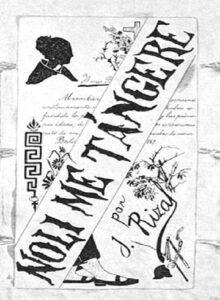 Noli Me Tangere: Unraveling the Essence of a Classic Masterpiece
Noli Me Tangere: Unraveling the Essence of a Classic Masterpiece
Introduction
“Noli Me Tangere” is a literary gem penned by the Filipino national hero, Dr. Jose Rizal. This timeless classic, published in 1887, has left an indelible mark on Philippine literature and society. The novel presents a gripping narrative set against the backdrop of Spanish colonial rule, exploring themes of love, betrayal, oppression, and the pursuit of justice. In this article, we will delve into the depths of “Noli Me Tangere,” analyzing its characters, themes, and significance in the context of Filipino history and culture.
The Origins of “Noli Me Tangere”
“Noli Me Tangere” was Rizal’s magnum opus, written during his stay in Europe as he yearned for reforms in his homeland. The title is Latin for “Touch Me Not,” taken from the Bible, and it reflects the protagonist’s plea for others not to touch his grave, thus preventing the spread of corruption. The novel was born out of Rizal’s desire to expose the injustices and abuses committed by the Spanish friars and colonial government.
Unveiling the Characters
3.1. Crisostomo Ibarra: The Protagonist
Crisostomo Ibarra, the novel’s central figure, is a young and idealistic Filipino educated in Europe. His return to the Philippines reveals the stark contrast between his progressive ideas and the prevailing backwardness in his homeland.
3.2. Maria Clara: The Beacon of Virtue
Maria Clara is the epitome of purity and grace. She is the daughter of Capitan Tiago and is betrothed to Crisostomo Ibarra. Her character symbolizes the innocence tainted by the oppressive forces of society.
3.3. Padre Damaso: The Embodiment of Corruption
Padre Damaso represents the abusive and exploitative nature of the Spanish friars. His actions and influence highlight the corruption that plagues the religious institution during the colonial era.
3.4. Elias: The Outlaw with a Cause
Elias is a mysterious and enigmatic character whose past is intertwined with the main plot. He becomes a symbol of resistance against tyranny and a champion of justice.
Themes and Symbolism
4.1. Love, Betrayal, and Forbidden Desires
The novel weaves a complex web of love and betrayal among its characters. It explores the consequences of forbidden relationships and the sacrifices one is willing to make for love.
4.2. Colonial Oppression and Social Injustice
“Noli Me Tangere” unflinchingly portrays the abuses and injustices suffered by Filipinos under Spanish colonial rule. Rizal denounces the oppressive regime and calls for social reform.
4.3. The Power of Symbolism
Throughout the novel, Rizal employs symbolism to convey deeper meanings and emphasize significant events. The use of symbols adds layers of complexity to the narrative.
Impact and Controversy
5.1. A Catalyst for Revolution
“Noli Me Tangere” played a pivotal role in sparking the Filipino nationalist movement and the fight for independence from Spain. It awakened the people’s national consciousness and inspired resistance against oppression.
5.2. Banned and Censored: The Suppression of Truth
The Spanish authorities, threatened by the novel’s powerful message, banned “Noli Me Tangere.” Despite censorship, the clandestine circulation of the book fueled the flames of resistance.
The Author’s Legacy
6.1. Jose Rizal: A National Hero
Jose Rizal’s influence extends beyond his literary contributions. He is hailed as a national hero and a symbol of Philippine patriotism and resilience.
6.2. “Noli Me Tangere” in Modern Filipino Society
The novel’s themes of justice, oppression, and love remain relevant in contemporary Philippine society. Rizal’s work continues to inspire and encourage discussions about social issues.
Unfolding the Story: A Chapter-by-Chapter Analysis
7.1. Chapter 1: A Homecoming with Secrets
The opening chapter introduces Crisostomo Ibarra’s return to the Philippines and sets the stage for the unfolding drama.
7.2. Chapter 15: The Confessions of a Spy
In this chapter, the secrets of a spy are revealed, leading to a chain of events with dire consequences.
7.3. Chapter 38: A Pact with the Devil
The gripping climax of the novel, Chapter 38, highlights the moral dilemmas faced by the characters and the ultimate resolution of the story.
Adapting “Noli Me Tangere”: Film, Theater, and Beyond
“Noli Me Tangere” has inspired numerous adaptations in various art forms. From films to theater productions, its enduring narrative continues to captivate audiences worldwide.
The Timeless Appeal of Rizal’s Masterpiece
The enduring relevance of “Noli Me Tangere” lies in its ability to resonate with readers across generations. Rizal’s masterful storytelling and powerful portrayal of societal issues continue to leave a lasting impact.
Conclusion
“Noli Me Tangere” stands as a testament to the power of literature in igniting social change. Jose Rizal’s timeless masterpiece has transcended its historical context, becoming a beacon of hope and inspiration for generations of Filipinos. The novel’s profound exploration of love, justice, and oppression remains a reminder that the struggle for truth and freedom is a battle worth fighting.
FAQs (Frequently Asked Questions)
- Is “Noli Me Tangere” based on real events?
- While the novel is a work of fiction, it is heavily influenced by the social realities and historical context of the Philippines under Spanish colonial rule.
- Why was “Noli Me Tangere” banned?
- The Spanish colonial authorities perceived the novel as a threat to their rule due to its bold critique of the oppressive system.
- What impact did “Noli Me Tangere” have on the Philippines?
- The novel played a crucial role in igniting the nationalist movement and awakening the Filipino people’s desire for independence.
- Are there English translations of “Noli Me Tangere” available?
- Yes, there are several English translations that allow non-Filipino speakers to access and appreciate Rizal’s masterpiece.
- How does “Noli Me Tangere” relate to modern Filipino society?
- The novel’s themes of social injustice, corruption, and the pursuit of justice remain relevant in contemporary Filipino society, making it a timeless literary classic.